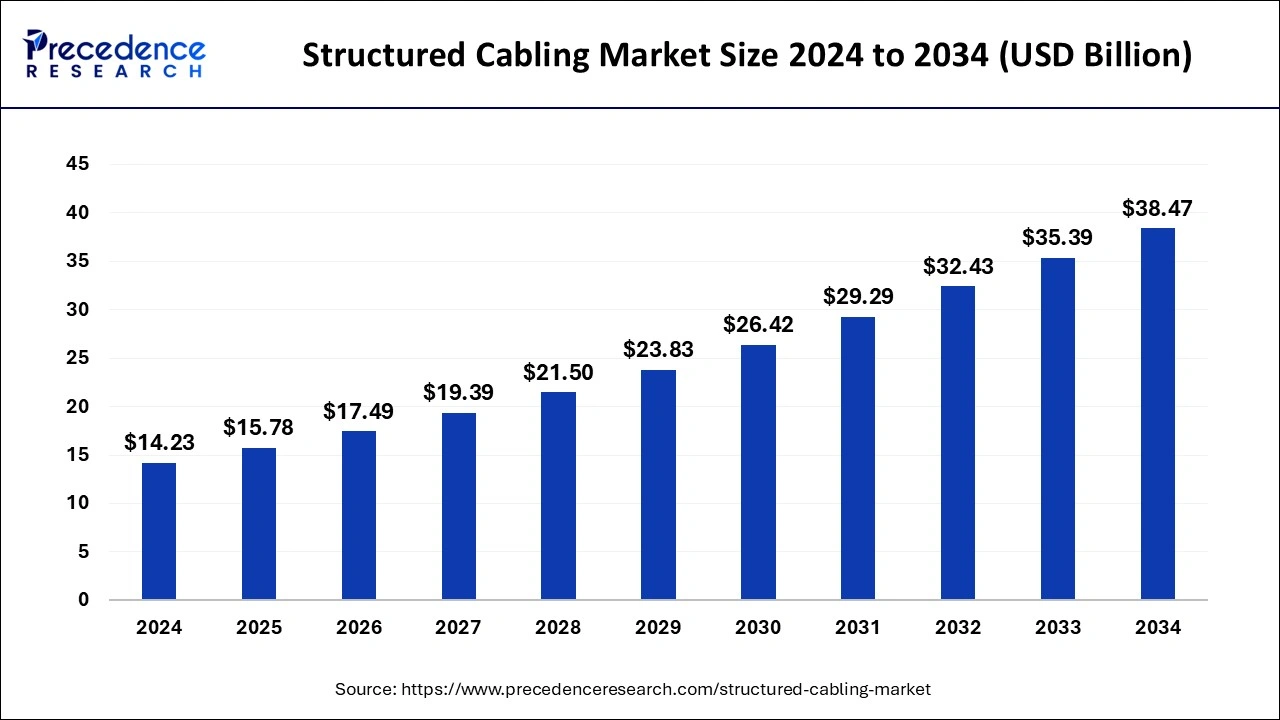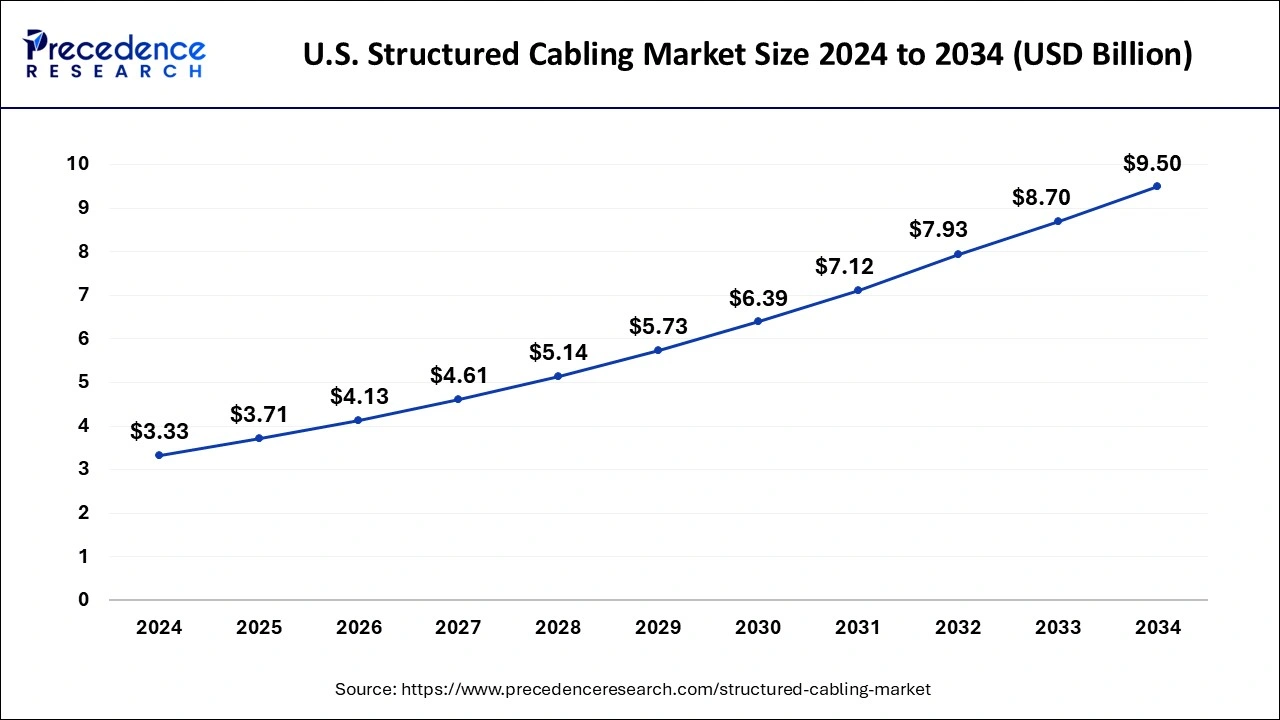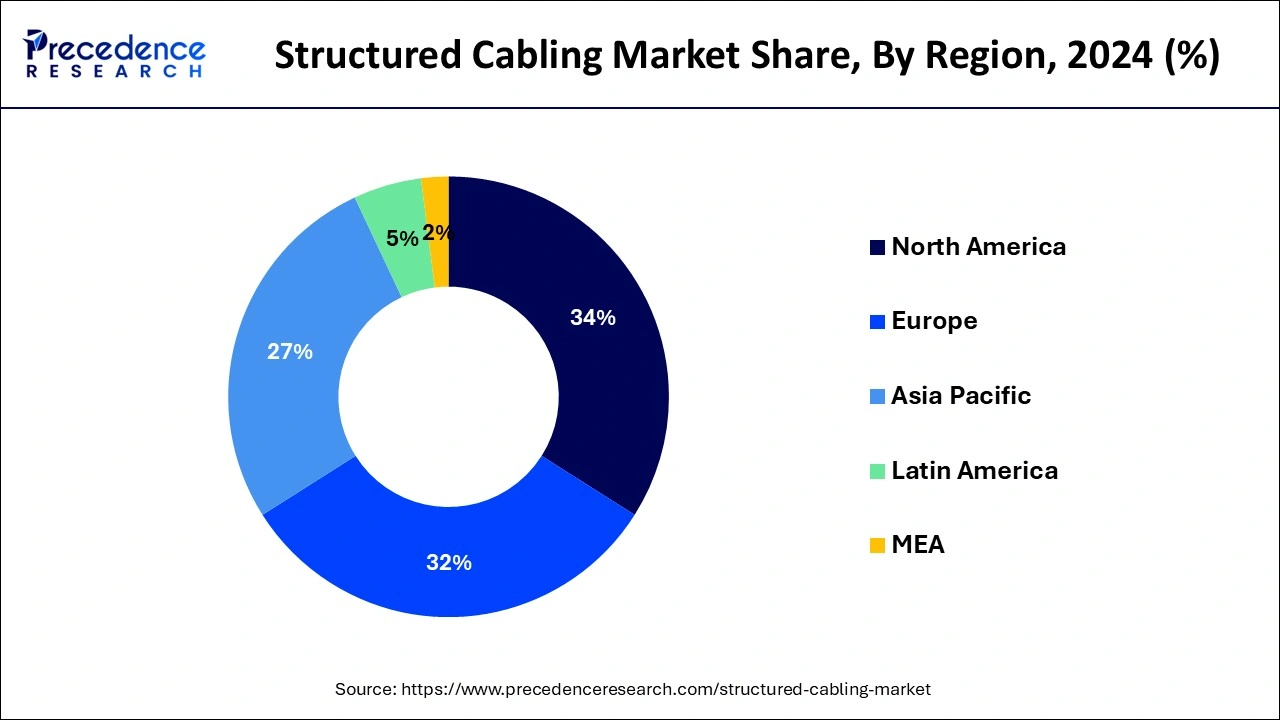The global structured cabling market size is calculated at USD 15.78 billion in 2025 and is predicted to surpass around USD 38.47 billion by 2034, accelerating at a CAGR of 10.46% from 2025 to 2034. The North America structured cabling market size surpassed USD 4.84 billion in 2024 and is expanding at a CAGR of 10.49% during the forecast period. The market sizing and forecasts are revenue-based (USD Million/Billion), with 2024 as the base year.
The global structured cabling market size was accounted for USD 14.23 billion in 2024, and it is expected to hit around USD 38.47 billion by 2034, poised to grow at a CAGR of 10.46% from 2025 to 2034.

The U.S. structured cabling market size reached USD 3.33 billion in 2024 and is anticipated to be worth around USD 9.50 billion by 2034, poised to grow at a CAGR of 11.05% from 2025 to 2034.

On the basis of geography, North America dominates the market, primarily driven by the growing demand for high-purity hydrogen in various industries. The region is expected to witness significant growth in the structured cabling market in the coming years, driven by technological advancements, increasing data and communication needs, data center expansion, industry standards, and the region's robust IT infrastructure. As organizations continue to invest in advanced networking technologies and digital transformation, the demand for structured cabling solutions is expected to remain strong in North America.

Europe is a significant market for structured cabling, with Germany, the United Kingdom, and France being the major contributors to the market's growth. This is due to the governments, businesses, and organizations in Europe making substantial investments in upgrading and expanding their IT networks to support digital transformation, cloud computing, IoT, and other emerging technologies.
The region in Asia-Pacific is anticipated to have the greatest CAGR. The market is driven by the increasing adoption of smartphones, e-commerce, online services, and digital technologies, and the demand for high-speed internet connectivity is rising. Structured cabling is vital in establishing reliable and high-bandwidth networks to support these digital services and facilitate digital transformation across industries.
Structured cabling is the standardized system of cabling infrastructure used to support various communication technologies within a building or campus. It involves the installation of a comprehensive network of cables, connectors, and related hardware to provide a reliable and efficient telecommunications infrastructure. Its primary purpose is to establish a unified platform for transmitting data, voice, video, and other communication signals throughout a facility. It is vital for various network systems, including local area networks (LANs), telephony systems, data centers, and audio-visual systems.
The structured cabling market encompasses the production, installation, and maintenance of structured cabling systems. It involves the various products, services, and solutions related to designing, implementing, and managing structured cabling infrastructure within buildings, data centers, and other facilities. The market is driven by the increasing demand for reliable and high-speed connectivity solutions to support organizations' growing data and communication needs. It caters to a wide range of industries, including IT and telecommunications, healthcare, manufacturing, government, finance, and retail.
Furthermore, increasing data and communication needs, adoption of high-speed networks, and scalable communication infrastructure that can support the increasing data and connectivity demands of modern organizations across various industries drive demand across the market. In addition, with the exponential growth of data traffic and the rising demand for high-speed and reliable connectivity, organizations require robust cabling infrastructure to support their data, voice, and video communication needs. Structured cabling provides a scalable, future-proof solution to accommodate expanding data requirements.
However, high initial installation costs, lack of flexibility in existing infrastructures, and complexity of installation and maintenance are anticipated to impede market growth. Structured cabling installations require skilled professionals with cable routing, termination, and testing expertise. The complexity of installation, especially in larger-scale projects, can pose challenges in terms of time, resources, and coordination. Similarly, ongoing maintenance and troubleshooting of structured cabling systems can be intricate and may require specialized knowledge.
| Report Coverage | Details |
| Market Size in 2025 | USD 15.78 Billion |
| Market Size by 2034 | USD 38.47 Billion |
| Growth Rate from 2025 to 2034 | CAGR of 10.46% |
| Largest Market | North America |
| Fastest Growing Market | Asia Pacific |
| Base Year | 2024 |
| Forecast Period | 2025 to 2034 |
| Segments Covered | By Type, By Cable Type, and By Application |
| Regions Covered | North America, Europe, Asia-Pacific, Latin America, and Middle East & Africa |
Increasing data and communication needs to brighten the market prospect
Organizations ever-increasing data and communication needs are driving the demand for structured cabling. As technology advances, businesses generate and transmit larger volumes of data, requiring a reliable and efficient infrastructure to support their communication networks. The exponential growth of data is fueling the demand for the structured cabling market. Organizations across various industries deal with massive amounts of data generated by applications, IoT devices, and digital processes. Structured cabling provides the backbone to handle this data influx, ensuring reliable and high-speed transmission throughout the network. For instance, in July 2021, Sterlite Technologies, a digital network integrator, launched NetXs, a next-generation suite of structured cabling solutions. NetXs offers superior performance for data transmission applications, catering to advanced networking solutions worldwide.
Furthermore, businesses need fast and reliable communication for applications like cloud computing, video conferencing, and real-time data transfer. Structured cabling, particularly fiber optic cabling, offers the bandwidth and speed required to support these bandwidth-intensive applications, enabling seamless and efficient communication. Organizations want a network infrastructure that can easily accommodate growth and adapt to changing needs. With structured cabling, adding or removing connections and devices becomes easier as the business expands or undergoes changes. This scalability ensures that the communication infrastructure can keep up with the evolving demands of the organization. Thus, organizations' increasing data and communication needs are the driving forces behind the growing demand for the structured cabling market.
Adoption of high-speed networks
As technology advances and organizations rely more heavily on fast and reliable connectivity, structured cabling emerges as a critical component to support these high-speed networks. With the growing volume of data being generated and transmitted, organizations require network infrastructure capable of handling large amounts of data quickly and efficiently. Furthermore, adopting high-speed networks, such as Gigabit Ethernet, 10 Gigabit Ethernet, and beyond, also contributes to the demand for structured cabling. These networks enable faster and more reliable communication, supporting bandwidth-intensive applications and services. Structured cabling systems offer the necessary infrastructure to establish these high-speed connections, ensuring organizations can leverage the full potential of their networks.
In addition, increasing reliance on cloud computing and virtualization is another factor driving demand for the structured cabling market. These technologies require robust, high-speed connectivity between servers, storage systems, and end-user devices. Structured cabling provides the foundation for these network architectures, enabling efficient and seamless communication within cloud environments and virtualized infrastructures. Several players are investing in various technologies to provide high bandwidth and data-intensive applications, further driving market demand. For instance, in July 2022, Lumen Technologies announced its plans to invest in edge networking to expand and enhance its edge computing solutions in Europe. The company intends to provide low-latency cloud and edge computing platforms, catering to businesses with high bandwidth requirements and data-intensive applications.
Moreover, the rising demand for multimedia content, video streaming, and real-time collaboration tools contributes to the need for high-speed networks. Structured cabling systems offer the capacity and performance required to deliver high-quality audio and video content, ensuring a smooth and immersive user experience. Thus, adopting high-speed networks is a significant driver for the demand in the structured cabling market.
The installation costs of structured cabling include various components such as cables, connectors, patch panels, network equipment, and professional installation services. These costs can quickly add up, especially when considering the need for skilled technicians to handle the installation process. As a result, organizations may hesitate or face budget constraints when considering structured cabling solutions. Moreover, the complexity of the installation process itself adds to the costs. Structured cabling installations require careful planning, cable routing, termination, and testing. These tasks often require specialized knowledge and expertise, leading to additional expenses in terms of labor and time. Larger-scale projects or installations in existing infrastructures may involve significant site preparation, cable runs, and coordination, increasing overall costs.
In addition, the high initial costs of structured cabling can be particularly challenging for small and medium-sized enterprises (SMEs) or organizations with limited budgets. The substantial upfront investment may deter these organizations from adopting structured cabling or lead to compromises in the quality or scale of the cabling infrastructure, potentially impacting their network performance and future scalability and further restraining demand for the structured cabling market.
On the basis of type, the structured cabling market is divided into fiber cabling, cabling infrastructure, and copper cabling, with the copper cabling segment accounting for most of the market. This is because the copper cabling provides versatility in supporting various data communication standards, including Ethernet, telephone systems, and video transmission. It can handle various data speeds, making it suitable for applications and network requirements.
On the basis of the cable type, the structured cabling market is divided into Cat 5E, Cat 6, Cat 6A, Cat 7/7A, and others (Cat 8), with Cat 6 accounting for most of the market. This is due to their enhanced performance compared to their predecessors, such as Cat 5 and Cat 5E. Cat 6 cables provide higher bandwidth and improved signal-to-noise ratio, allowing faster data transmission rates and better network performance.
On the basis of application, the structured cabling market is divided into local area network (LAN) and data center, with the local area network (LAN) segment accounting for most of the market. This is because LANs enable internal communication and data sharing within organizations. They facilitate seamless connectivity among computers, printers, servers, and other network devices, enabling efficient collaboration and resource utilization. In addition, LANs are widely used in various environments, such as offices, educational institutions, healthcare facilities, and retail spaces. LANs provide network connectivity within a limited geographic area, allowing users to share resources, access the internet, and communicate with each other.
On the basis of the end-user, the structured cabling market is divided into residential, commercial, and industrial, with industrial accounting for most of the market. The industrial sector encompasses various industries such as manufacturing, oil and gas, automotive, chemicals, and more. These industries often have complex and demanding networking requirements to support their operations, including automation, process control, machine-to-machine communication, and data-intensive applications. Structured cabling is critical in providing reliable and efficient connectivity within industrial environments, ensuring seamless communication and data transmission.
By Type
By Cable Type
By Application
By Geography
For inquiries regarding discounts, bulk purchases, or customization requests, please contact us at sales@precedenceresearch.com
No cookie-cutter, only authentic analysis – take the 1st step to become a Precedence Research client